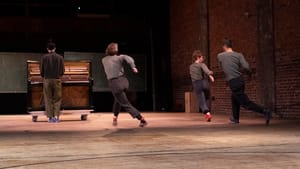Stay in the Loop
BSR publishes on a weekly schedule, with an email newsletter every Wednesday and Thursday morning. There’s no paywall, and subscribing is always free.
The fallout of modernization
The Philadelphia Dance Project presents Tori Lawrence & Co.’s ‘Junkspace’

When we arrived at the Christ Church Neighborhood House performance space, Philadelphia Dance Project director Terry Fox announced that the doors would not open until five minutes before the start of Tori Lawrence’s Junkspace. Fox invited the gathered audience to watch the creator’s unrelated video work in progress, in which a performer in white, with bare feet and a white box on the dancer’s head, wandered carefully through a desert canyon. It reminded me of founding Dadaist Hugo Ball at the Cabaret Voltaire, reciting wordless poetry in a cardboard costume.
Performance art as we know it today grew out of Dadaism and the politics of anti-art, but we tend to forget that dance had its Dadaists, too. If the title hadn’t done so already, the headless figure wandering in the desert certainly warned us that Junkspace would be a kind of anti-art in dance for our time.
What remains
In the program notes, Lawrence quotes Dutch architect Rem Koolhaas: “The built product of modernization is not modern architecture but Junkspace. Junkspace is what remains after modernization has run its course…its fallout.” Lawrence first performed the piece in Philly at the abandoned H.G. Fetterolf Co. factory on Stenton Avenue in May 2019. She subsequently adapted it for the Neighborhood House, which is not an abandoned monument to modernist industry, but shares in that industrial aesthetic. Its civilized exterior hides a black-box performance space marked by raw brick and large, brick-framed windows. More indicative of its purpose over time as a parish community space, the wood floor is painted with a basketball court.
The stage and the sounds
For this show, a single row of folding chairs lined the two long, rough brick walls. We faced each other across a floor bare except for that basketball court and two lengths of rope bisecting the space on the diagonal. A staircase painted black led up to a tech loft at one end, and three large chalkboards gave access to the wings on the other.
In one corner, Cole Bjeli performed a haunting abstract-noise piece on amplified cello. Then a new sound intruded: dancer Jungwoong Kim entering through the tech loft. The microphones on his shoes amplified each step grinding on the dusty floor as he crept painfully down the stairs. He wore a green sweatshirt and gray pants, and his sneakers were tied to the ropes, so that they dragged behind him as he slowly crossed the performance area. He disappeared behind a chalkboard and a loud woody groan, like the percussion accompaniment to the cello, announced Kim’s return, pushing a small desk and chair (also with amplified sound) to the center of the room.
And then they danced
The soundscape, which included low-sung tones by sound designer Seth Wenger, served a dreamlike accompaniment to Kim’s manipulation of the space, but just as I started to grow impatient for some dancing, Kim put away the desk and the ropes and shed the microphones from his feet. His dance combined martial forms, particularly in the framing of his arms, with a pared-down, minimal style.
Jenna Riegel entered next, then Ellie Goudie-Averill joined them with movements centered on curled shoulders and flexible ankles, balanced by loosely bent knees. I was scratching my head a bit when they started running madly back and forth until I let the fact of the space in front of me sink in—a basketball court. Of course!
As the dance moved from vignette to vignette, Bjeli moved from cello to hammered dulcimer. A piano sat on a dolly that Wenger moved about the floor, vocalizing almost at the limit of hearing while Bjeli played as they walked. The soundscape mesmerized without ever descending into melody. If the dancers played with time and space, the musicians rode above it all, making time disappear.
The politics of spaces
I wish I had seen the performance on Stenton Avenue last May. An abandoned factory certainly meets the definition of junkspace that Koolhaas posits, and an artistic examination of the politics of such spaces makes urgent sense in the context of a city’s crumbling infrastructure. To some extent, the Neighborhood House fits the bill. It was built in 1915, to serve a low-income parish. But the neighborhood has changed.
Since 1990, the fourth-floor black-box has become one of the city’s busier performance spaces. Renovations completed in 2010 brought it into ADA compliance and added air conditioning while conserving the space’s origins. So the collaborative process between Lawrence’s company and neglected space seems incomplete. Is a political act, removed from its context, still a political statement? By what criteria does it wish to be judged—as art, or anti-art? Or does it rest between the two—a simulacrum of them both, or a mirror reflecting on its intentions?
What, When, Where
Junkspace. By Tori Lawrence. Presented by the Philadelphia Dance Project’s Midwinter Festival on February 22 and 23, 2020, at the Christ Church Neighborhood House, 20 North American St., Philadelphia. (215)-546-2552 or philadanceprojects.org.
Christ Church Neighborhood House is an ADA-compliant venue.
Sign up for our newsletter
All of the week's new articles, all in one place. Sign up for the free weekly BSR newsletters, and don't miss a conversation.

 Camille Bacon-Smith
Camille Bacon-Smith